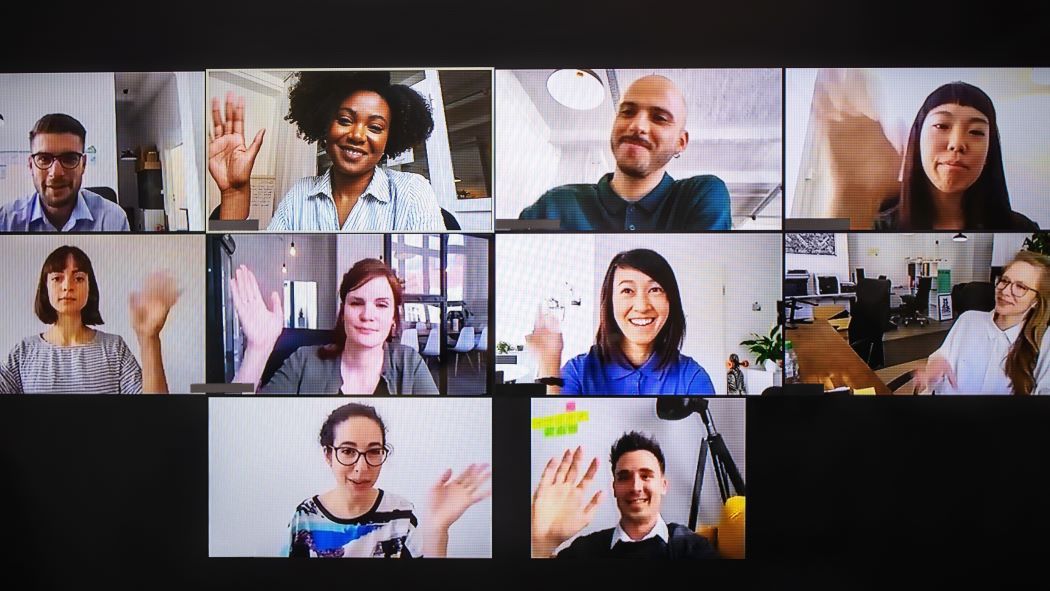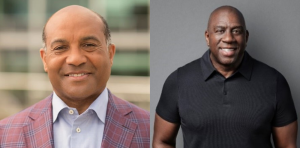
Healthy employees are good for business. Period.
 That was the key takeaway of a discussion led by Earvin "Magic" Johnson (right) and Cigna's U.S. Commercial President, Mike Triplett (left, next to Johnson), in which a panel of industry experts explored why the health of employees matters more than ever. Panelists from Cigna, as well as the Atlanta Hawks and State Farm Arena, spoke to strategies that can help improve the health and productivity of an organization’s workforce and how a healthy workforce can drive the bottom line.
That was the key takeaway of a discussion led by Earvin "Magic" Johnson (right) and Cigna's U.S. Commercial President, Mike Triplett (left, next to Johnson), in which a panel of industry experts explored why the health of employees matters more than ever. Panelists from Cigna, as well as the Atlanta Hawks and State Farm Arena, spoke to strategies that can help improve the health and productivity of an organization’s workforce and how a healthy workforce can drive the bottom line.
“As businesses look to recover from the economic impact of the pandemic, it will be important that they have a healthy and productive workforce,” said Johnson.

Better Health. Better Business.
Listen to the replay of the panel discussion where Cigna, Earvin "Magic" Johnson, and industry experts explore ways that organizations both big and small can foster workforce health and well-being.
Below we take a look at some of the most interesting insights to come from the discussion.
Employee Health and Well-Being Rests its Laurels on Company Culture
 According to Monica Schmude (left), Mid-Atlantic market president with Cigna, company culture plays a role in fostering workforce health and well-being. She said this isn’t a new phenomenon: Company culture has always been important in the context of business growth. However, the pandemic has pushed it to become a c-level imperative and part of the growth plan for businesses moving forward.
According to Monica Schmude (left), Mid-Atlantic market president with Cigna, company culture plays a role in fostering workforce health and well-being. She said this isn’t a new phenomenon: Company culture has always been important in the context of business growth. However, the pandemic has pushed it to become a c-level imperative and part of the growth plan for businesses moving forward.
“The pandemic has caused us to rethink the nature of work itself,” Schmude said. “…When we think about work, it is more about work as something that we do and less about work as a place we go to. For me, that’s company culture and [figuring out] how to support that environment [is important]. We can either foster that as part of our culture or we can hinder [it].”
Schmude says that modern, forward-thinking organizations have embraced that a healthy workforce leads to a healthier business, and not just in the sense of lower-cost health care, either. She encourages organizations to dig into the numbers: Healthy workforces are more engaged and more committed to the work that they do.
A Gallup poll shows that disengaged employees cost companies 18% of their annual salaries. Furthermore, disengagement leads to higher absenteeism, lower productivity and lower profitability for the organization as well. Contrary to that is the fact that businesses with higher employee engagement are 23% more profitable, according to research.
“[At Cigna, we want] employees coming to work with a sense of belonging, and that connection to work,” Schmude said. “[We want them] to feel [they] belong here and [their] work matters. [They need to] feel supported in this [new] work environment. That’s all part of the company culture that can be created. …Because when employees can bring their best selves to work and they feel supported [organizations get] optimal performance and great business results.”
A Culture that Fosters Health and Well-being Attracts top Talent
Company culture, Schmude said, plays a key role in helping an organization both attract and retain top talent. And it starts at the top, with leadership. Leaders, she said, must acknowledge and understand their people’s needs so that they can empower their teams to bring their best selves to work every day.
When looking at what’s important to employees, it’s not what one might have guessed, Schmude said. According to Gallup, 35% of employees said that improving the benefits package is one of the things that a company can do to help them in their job. Improved benefits comes in second on the list of priorities for employees, with increased pay at the top of the list.
“Salary increases are important, but second to that is the benefit plan,” Schmude said. “And that sits in the [Gallup] poll ahead of things like job promotion and opportunities.”
Gallup also found that six in 10 employees said they would be likely to take a different job with lower pay if the benefits were higher. Additionally, employees want their employers to foster a culture of well-being, and they’ll leave a job to find it.
“Generationally, for Millennials and Gen Z, that’s the [No. 1] thing they look for in an employer,” Schmude said. “They also look at … the company’s diversity, equity and inclusion strategy, [and] …ethical behavior of companies.”
The common theme across all of the various research coming out recently, is that employers can use their benefit plans to lean into the culture they are creating by tailoring benefits for each part of their workforce (think: Caregivers vs. women vs. the Black community, etc.). Understanding employee needs is key – and bringing forth solutions to meeting those needs is becoming table stakes, Schmude said.

Your New Growth Plan: A Happy, Healthy Workforce
Your company likely sees health care primarily as a cost. But what if you could turn it into an investment in the growth of your business?
The Impact of the Pandemic on the Health of America’s Workforce
 Jason Youngblood (right), director of U.S. markets, behavioral center of excellence and sales operations at Cigna, said that the impact of the pandemic on our workforce has been “absolutely brutal.”
Jason Youngblood (right), director of U.S. markets, behavioral center of excellence and sales operations at Cigna, said that the impact of the pandemic on our workforce has been “absolutely brutal.”
Consider that today, workforce employees are more likely to report feelings of depression and burnout than they were prior to the pandemic. And 40% of employees and business leaders report that they rank stress, burnout and other mental health issues as the biggest barrier to their organization’s bottom line. Poor mental health and stress, of course, decreases productivity and employee engagement, while also increasing poor communication. Working moms, in particular, have had it rough throughout the pandemic, Youngblood said. Eighty percent of working moms report that their mental well-being is at risk.
“And for those of us who manage teams, we can see the disastrous impact of poor communication within our teams and with the clients and customers that we support,” Youngblood said. “We also understand that folks who are at-risk for depression, typically have higher health care costs overall, which can also impact the bottom line. We need to consider that today, one of every 11 of our employees is likely facing a substance use disorder. …That’s the environment that we are in today.”
Poor mental health can negatively impact employee engagement, he added, with a stat to support: Today just 36% of employees report feeling engaged at work.
“That means that the vast majority of people in the workforce feel disengaged at this time,” he said, adding that leaders will have their work cut out for them.
How Companies – Both Big and Small – Can Build a Culture of Health and Well-Being
All companies have seen an increase in employee burnout throughout the pandemic, and Cigna claims data shows people have also been neglecting getting treatment for both their mental and physical health—especially in those early months when COVID-19 first emerged. Add to that the stress of also having to be a full-time caretaker when work-at-home orders first went out, and it’s clear to see that America’s workforce has just weathered one of the greatest storms of the last century.
And we are seeing the repercussions: According to Cigna data, one in four Americans are struggling with depression. Almost 50% of the population reports feeling lonely due to social isolation, and 30% have developed generalized anxiety disorder. And, twice as many people considered suicide in 2020 than in 2018.
“Employers need to think about that burnout factor … [and they need] to be intentional about [their] strategies to address it,” Schmude said. “…You need pieces of the benefits plan to address [these needs].”
 Camye Mackey (left), EVP and chief people, diversity, equity and inclusion officer for the Atlanta Hawks and State Farm Arena, echoed Schmude’s thoughts around the importance of employee experience and culture work in today’s workplace.
Camye Mackey (left), EVP and chief people, diversity, equity and inclusion officer for the Atlanta Hawks and State Farm Arena, echoed Schmude’s thoughts around the importance of employee experience and culture work in today’s workplace.
One of the things that the Atlanta Hawks and State Farm Arena created is a customer service philosophy called S.M.I.L.E.
- Southern Hospitality – Being welcoming, courteous and making sure to take care of people’s needs
- Make it a Moment – Whenever you can, make a moment for someone (a birthday cake, recognition in front of others, etc.)
- Individuals Matter – Understand people as individuals because we are all different. You have to know someone to better serve them.
- Listen and Learn – Actively listening to what people say, and acting on what people say.
- Empowerment – Empower your workforce, and show them you trust them to make decisions.
“I know sometimes it seems so simple, but just think about it: When someone smiles, it’s contagious. It’s a feeling … It makes you feel warm, welcomed and a part of something. We created a customer service philosophy that we use with our employees and with our fans. One of our purposes at the Atlanta Hawks and State Farm Arena is to create memorable experiences for our fans, but we know that starts with our experience as team members,” said Mackey.
According to Mackey, the more you develop your leaders, the more they will then, in turn, develop and prioritize your workforce. And, the more you prioritize your workforce, the better the experience becomes for fans and customers.
For small businesses, fostering a healthy workforce might seem like an expensive dream. But, Mackey, said, there are lot of things that a small company can do – with a big impact – that won’t break the bank. For instance, leaders can model the behavior that they would like to see.
“When we think about health … it’s OK to say, ‘I’m leaving early because I have a wellness visit at my doctor’s office,’” Mackey said, adding that leaders might also consider talking about the things they do to lead more healthy lives (i.e. exercise routines, how they strive for work-life balance, and more). Being transparent goes a long way.
Making people feel appreciated, she added, and bringing that flexibility into the workplace is key. Mackey, for example, sends resources she runs across online for working moms to women who are also caregivers.
“When you look at culture and the experience we create for our team members, it’s critical because they are watching all of the behaviors and what we are doing. Now more than ever, it’s critical for us to look at the whole team member, and not just the work product that they bring to work each and every day.”
Youngblood echoed Mackey’s thoughts but also added that mental health issues among employees aren’t always visible. And the truth is that out of all of the people who have a behavioral or mental health problem, less than half ever move on to seek treatment. That’s why, Youngblood said, it is important that companies work with a benefit carrier that prioritizes the health of both the mind and the body. He also suggested looking for a carrier that uses data to uncover and then reach out and engage people who might be suffering from behavioral health conditions and getting them engaged early on. “It’s important to focus on mind and body and to ensure that your benefits are pulling them together,” he said.
Youngblood also encouraged viewers to remember the Employee Assistance Program, which can be helpful for employees and managers.
Businesses Must Understand the Health Disparities that Impact the Workforce
 Kimberly Funderburk (right), national VP and general manager for government & education, Cigna, said that while the pandemic has been hard on us all, underserved populations, such as the Latino and Black communities, have certainly felt the repercussions of health inequity during COVID-19. “They had it especially hard,” she said, adding that health disparity has an effect on businesses’ bottom line.
Kimberly Funderburk (right), national VP and general manager for government & education, Cigna, said that while the pandemic has been hard on us all, underserved populations, such as the Latino and Black communities, have certainly felt the repercussions of health inequity during COVID-19. “They had it especially hard,” she said, adding that health disparity has an effect on businesses’ bottom line.
The National Partnership for Action defines health disparity as: “A particular type of health difference that is closely linked to socio or economic disadvantage.” Health disparity can impact racial or ethnic groups, religion, socio-economic status, gender, age, mental health, disabilities, and sexual orientation—really anything that’s been linked to discrimination, Funderburk said.
“Health disparities impact all of us in one way or another,” she said. “They impact individuals, families, employers, communities, and the nation at large. …We all benefit from the elimination of health disparities."
Eliminating health disparities has the potential to lower health care costs, Funderburk said. Health equity would mean better health outcomes and better quality of life for Americans.
“Health disparities don’t stay at home when we go to work,” she said. “Since our workforces reflect the communities where we live and work, they come right into our organizations, and we have to deal with them.” But like mental health, health disparities aren’t always visible. But they surely impact companies, and can come in the form of presentism and absenteeism, productivity and organizational effectiveness, as well as bottom line.
Funderburk believes that health equity is achievable, but only if we all have a shared purpose and work together across the private and public sector. Step one is understanding the macro challenge + the direct and indirect impact on our organizations.
“[Employees] are ready to act and drive healthy change and employers play an important role … in offering that support to address those health disparities among their employees,” Funderburk said. “…80% of an individual’s health outcomes are driven by health behaviors and the environment where they live, work and play – and that is key when you are having the health disparities conversation. There is a higher prevalence of barriers and risk factors in diverse populations. And the truth is these barriers lead to poor outcomes and these poor outcomes lead to increased costs.”